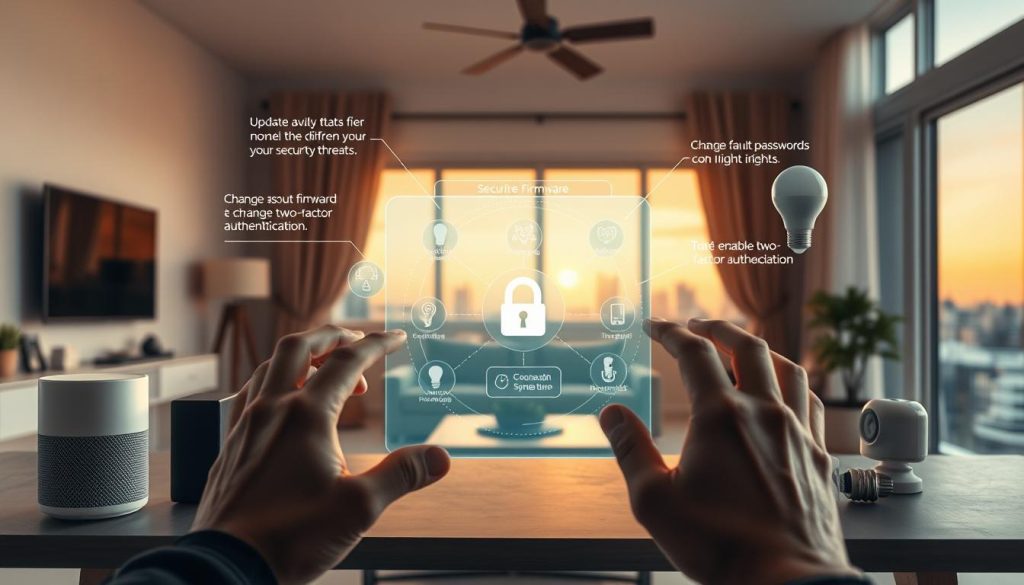You’ve invested in a smart home to make your life easier and safer. But, with more connected devices, your home network faces cybersecurity threats. Ransomware, a harmful malware, can encrypt your files and lock your devices, making them unusable.
Ransomware attackers ask for money to unlock your devices. As a smart home owner, knowing the risks of ransomware is key. It’s important to protect your devices and data from these threats.
Key Takeaways
- Ransomware is a malicious malware that can encrypt your files and lock your devices.
- Cybersecurity threats are on the rise, and smart homes are vulnerable.
- Understanding ransomware is crucial to protecting your devices and data.
- Proactive measures can help prevent ransomware attacks.
- Smart home security is essential to safeguarding your personal data.
What Is Ransomware and How Does It Work?
It’s important to know about ransomware to keep your smart home safe. Ransomware is a bad software that finds weak spots in systems, like your smart home.
Definition of Ransomware
Ransomware locks your files with a code. You can’t get them back until you pay a ransom. It can hit many devices, from phones to smart home gadgets. The main goal is to make money by taking your data hostage.
Ransomware attacks can be very harmful. They can cost you a lot of money and cause a lot of trouble. Knowing how it works helps you protect your devices better.
Common Methods of Attack
Ransomware gets into devices in a few ways:
- Phishing emails that trick you into downloading bad stuff or clicking on links.
- Using old software with known bugs.
- Tricking you into sharing personal info or installing malware.
Knowing these tricks helps you avoid getting hit by ransomware. Keeping your software current and being careful with emails and links is key to protecting your smart home.
The Encryption Process
When ransomware hits, it starts encrypting your files. It uses strong codes to make them unreadable. This happens fast, and it’s hard to catch it in time.
Here’s how the encryption works:
| Step | Description | Impact |
|---|---|---|
| 1. Infection | Ransomware malware infects the device. | Initial breach of security. |
| 2. Scanning | Ransomware scans for files to encrypt. | Identification of valuable data. |
| 3. Encryption | Files are encrypted using complex algorithms. | Files become inaccessible. |
| 4. Ransom Demand | A ransom is demanded for the decryption key. | Victim is forced to pay or lose data. |
To keep your Internet of Things secure, protect all connected devices. Update them often and use strong passwords. This can really lower your risk of getting hit by ransomware.
By learning about ransomware and taking steps to prevent it, you can keep your smart home safe. Staying informed is the best way to Ransomware Awareness and protect your digital world.
The Growing Risk of Smart Home Devices
IoT devices are set to hit 17 billion globally, making them prime targets for ransomware. As smart home tech becomes more common, the dangers it poses grow too.
Trends in Smart Home Adoption
Smart home devices are getting more popular. They offer convenience and new features, making them key parts of our homes. From smart thermostats to security cameras, they’re everywhere.
Key statistics on smart home adoption include:
| Category | 2019 | 2020 | 2021 |
|---|---|---|---|
| Smart Speakers | 100 million | 150 million | 200 million |
| Smart Thermostats | 20 million | 30 million | 40 million |
| Security Cameras | 50 million | 70 million | 100 million |
Vulnerabilities of IoT Devices
IoT devices often have weaknesses that hackers can use. These weaknesses come from bad passwords, old software, and weak security.
Common vulnerabilities include:
- Weak passwords and authentication mechanisms
- Outdated firmware and software
- Lack of encryption

Recent Ransomware Attacks
Ransomware attacks on smart home devices are getting more common and complex. Hackers are using IoT device weaknesses to get into home networks and steal data.
Notable examples of ransomware attacks on smart home devices include:
- The Mirai botnet attack, which exploited weak passwords in IoT devices
- Ransomware attacks on smart home hubs and routers
To protect your smart home, use strong passwords, update software regularly, and add strong security measures.
How Ransomware Targets Smart Home Systems
Ransomware is a big threat to smart home security. Attackers use different tactics to get into devices and ask for money. With more smart home devices, there’s more chance for ransomware attacks.
Entry Points for Attackers
Attackers get into smart homes through weak spots. These can be:
- Unsecured Wi-Fi networks
- Old firmware on devices
- Devices with simple or default passwords
Securing these spots is key to stop ransomware. Make sure your Wi-Fi is safe and all devices have the latest firmware. This can really lower the risk.
Exploiting Weak Passwords
Weak passwords are a big problem. Using simple or default passwords makes it easy for attackers to get into your smart home.
Good password habits mean using strong, unique passwords for each device. Change them often too.
| Password Type | Security Level | Risk of Exploitation |
|---|---|---|
| Default/Easy | Low | High |
| Complex/Unique | High | Low |
Malware via Compromised Networks
Attackers also spread malware through infected networks. If one device gets infected, it can harm others on the network.
Using good antivirus and keeping your network’s security up to date can help fight this.

Knowing how ransomware attacks smart homes helps you protect your devices and data. Take steps now to keep your smart home safe.
Identifying the Signs of a Ransomware Attack
It’s important to know the signs of a ransomware attack on your smart home devices. This knowledge helps you act fast to reduce damage. Ransomware can show up in different ways, so being alert is key.
Unusual Device Behavior
One early sign is when your devices act strangely. You might see slow performance, unresponsive screens, or unusual pop-ups. If your smart TV starts on its own or your thermostat changes without you, it’s a red flag.
Locked Devices and Files
Ransomware often locks your devices or files. You might find your smartphone, computer, or files are locked, with a ransom note. This is a clear sign of trouble.
Ransom Notes and Messages
Ransomware attacks often come with ransom notes. These messages ask for money to unlock your devices or files. They can pop up as alerts, texts, or emails. Be careful with these messages and don’t pay without checking the situation first.
| Signs of Ransomware | Description | Action |
|---|---|---|
| Unusual Device Behavior | Slow performance, unresponsive screens, unusual pop-ups | Disconnect device from network, run a virus scan |
| Locked Devices and Files | Devices or files are inaccessible, ransom demand | Do not pay ransom, restore from backup if available |
| Ransom Notes and Messages | Pop-ups, text messages, or emails demanding payment | Report to authorities, seek professional help |
Knowing these signs can boost your Smart Home Security and Internet of Things Security. Keep an eye on your devices and update your security regularly. This is crucial to protect your smart home from ransomware.
Preventive Measures for Smart Home Security
To keep your smart home safe from ransomware, you need strong security steps. It’s not just about keeping your data safe. It’s also about making sure your daily life keeps going smoothly.
Importance of Regular Software Updates
Keeping your smart devices updated is key to their security. Updates often fix holes that hackers could use. By updating regularly, you lower the chance of a ransomware attack.
Best Practices for Updating Your Devices:
- Enable automatic updates whenever possible.
- Regularly check for updates on devices that do not support automatic updates.
- Update all devices, including routers and smart home hubs.
Best Practices for Password Management
Good password habits are crucial for smart home safety. Strong, unique passwords for each device and account make it tough for hackers to get in.
| Password Practice | Benefit |
|---|---|
| Using a password manager | Generates and stores complex, unique passwords |
| Avoiding common passwords | Reduces the risk of unauthorized access |
| Changing passwords regularly | Minimizes the impact of a potential data breach |
Using a VPN for Added Security
A Virtual Private Network (VPN) adds extra security by encrypting your internet. This makes it harder for hackers to get your data or put malware on your devices.
When choosing a VPN, consider factors such as:
- Encryption protocols used
- Server locations and coverage
- User reviews and ratings

By taking these steps, you can make your smart home much safer. This helps protect your devices from ransomware attacks.
Responding to a Ransomware Attack
If your smart home gets hit by ransomware, knowing how to act fast can save you a lot. Ransomware attacks can really mess up your smart home devices. They might even lock you out of your digital life.
Disconnecting Infected Devices
The first thing to do is disconnect infected devices from your network. This stops the malware from spreading to other devices. It’s very important to do this right away to stop the attack.
- Turn off the device or disconnect it from the power source.
- Disconnect from the internet to prevent further communication with the attacker’s server.
- Isolate the device from other smart home devices.
Reporting the Attack
After stopping the attack, you should report it. This gets you help and might help catch the attackers. Reporting ransomware attacks is very important for your safety.
- Notify your internet service provider about the attack.
- Report the incident to local law enforcement or a national cybersecurity agency.
- Inform the manufacturer of your smart home devices.
Assessing Damage and Recovery Options
After stopping and reporting the attack, check the damage. See which devices are affected and what data is lost or encrypted. Knowing how bad it is helps you fix it.
Think about these ways to recover:
- Restoring data from backups, if available.
- Using decryption tools provided by cybersecurity companies, if applicable.
- Seeking professional help from cybersecurity experts.

By acting fast and following these steps, you can lessen the damage from a ransomware attack on your smart home. Remember, prevention is key, but being ready to respond is just as important.
The Role of Antivirus and Security Software
Ransomware attacks are getting smarter, making antivirus and security software key for smart homes. You need strong protection to keep your devices safe from new threats.
Recommended Security Solutions
To keep your smart home safe, you need comprehensive security solutions. This includes antivirus software to find and remove malware. Also, firewalls block unauthorized access to your network. Choose software that offers real-time protection and works well with IoT devices.
When picking security software, look for these features:
- Malware detection and removal
- Firewall protection
- Regular software updates
- Compatibility with multiple devices
Benefits of Comprehensive Coverage
Comprehensive security gives multiple layers of protection for your smart home. Even if one layer is broken, others can still protect you. It covers various malware, phishing, and cyber threats.
With comprehensive coverage, you can:
- Lower the risk of ransomware
- Keep your data safe
- Keep your smart home running smoothly
Regular Scanning and Monitoring
Regular scanning and monitoring are vital for good security software. They spot threats early. Scans find malware that real-time protection might miss. Monitoring alerts you to any odd activity.
To get the most from your security software, make sure:
- Scans happen often, like daily or weekly
- Monitoring is always on, for 24/7 protection
- Alerts are quickly checked to stop threats
Educating Family Members and Users
In today’s world of smart homes, everyone needs to know about cybersecurity. Ransomware attacks are getting smarter, so it’s key that everyone understands the risks. They should also know how to stay safe.
Raising Awareness of Ransomware Risks
Ransomware can sneak in through phishing emails and infected downloads. It’s vital to teach your family to avoid suspicious links and unknown attachments. Talking about cybersecurity often helps keep everyone alert.
To spread the word, try these tips:
- Hold family meetings to talk about staying safe online.
- Share news about ransomware attacks to keep the topic fresh.
- Encourage everyone to report any odd emails or activities.
Safe Browsing Practices
Safe browsing is crucial to avoid ransomware. Using strong, unique passwords and two-factor authentication boosts security. Also, make sure your browser and plugins are always updated.
| Safe Browsing Practice | Benefit |
|---|---|
| Using strong, unique passwords | Prevents unauthorized access to accounts |
| Enabling two-factor authentication | Adds an extra layer of security |
| Keeping browser and plugins updated | Protects against known vulnerabilities |
Importance of Phishing Detection
Learning to spot phishing is essential. Teach your family to recognize phishing attempts to lower the risk of scams. Watch out for emails with typos, generic greetings, and dodgy links.
To spot phishing, remember these tips:
- Be wary of emails that ask for personal info.
- Check the sender’s email address to make sure it’s real.
- Don’t click on links or download attachments from unknown emails.
By teaching your family about these important topics, you can make your smart home safer against ransomware attacks.
Future Trends in Ransomware and Smart Homes
Technology is changing fast, and so is the world of ransomware and smart homes. The future of cybersecurity threats, especially ransomware, will depend on how smart home devices evolve. It also depends on how well we protect them.
Predictions for Ransomware Evolution
Ransomware will get smarter, targeting more than just computers. It will go after IoT devices too. Hackers might use smart home weaknesses to get to our personal info or mess with our homes.
Potential Targets:
- Smart Speakers and Voice Assistants
- Home Security Cameras and Alarms
- Connected Appliances and Entertainment Systems
The Impact of AI on Cybersecurity
Artificial Intelligence (AI) will be big in cybersecurity, both for attacks and defense. AI can help hackers make ransomware attacks better. But, AI can also help protect us by finding and stopping threats faster.
Key Benefits of AI in Cybersecurity:
- Enhanced Threat Detection
- Predictive Analytics for Proactive Defense
- Automated Incident Response
Innovations in Smart Home Defense Systems
The future of smart home security is all about new defense systems. These will include better encryption, AI security tools, and stronger network security. These innovations will help fight off ransomware threats.
| Innovation | Description | Benefits |
|---|---|---|
| Advanced Encryption | Enhanced data protection methods | Secures sensitive information |
| AI-Driven Security | Real-time threat detection and response | Proactive defense against ransomware |
| Robust Network Security | Improved network protocols and firewalls | Prevents unauthorized access |
Knowing about these trends helps you get ready for the future of ransomware and smart home security.
Conclusion: Staying Proactive Against Ransomware
Ransomware is a big threat to your Smart Home Security. It’s important to stay ahead of it to protect your devices and data. By knowing the risks and taking steps to prevent them, you can lower the chance of an attack.
Key Takeaways for Securing Smart Devices
To stay safe from ransomware, keep your software current and use strong passwords. Also, be careful when you’re online. Regular updates and antivirus software can block attacks.
Ongoing Education and Vigilance
It’s key to know the latest threats and how to protect your smart home. Teach yourself and your family about safe browsing and protecting smart devices.
Resources for Further Learning
For more tips on keeping your smart home safe from ransomware, check out trusted cybersecurity sites. Stay current with security news. This will help you protect your digital world.

